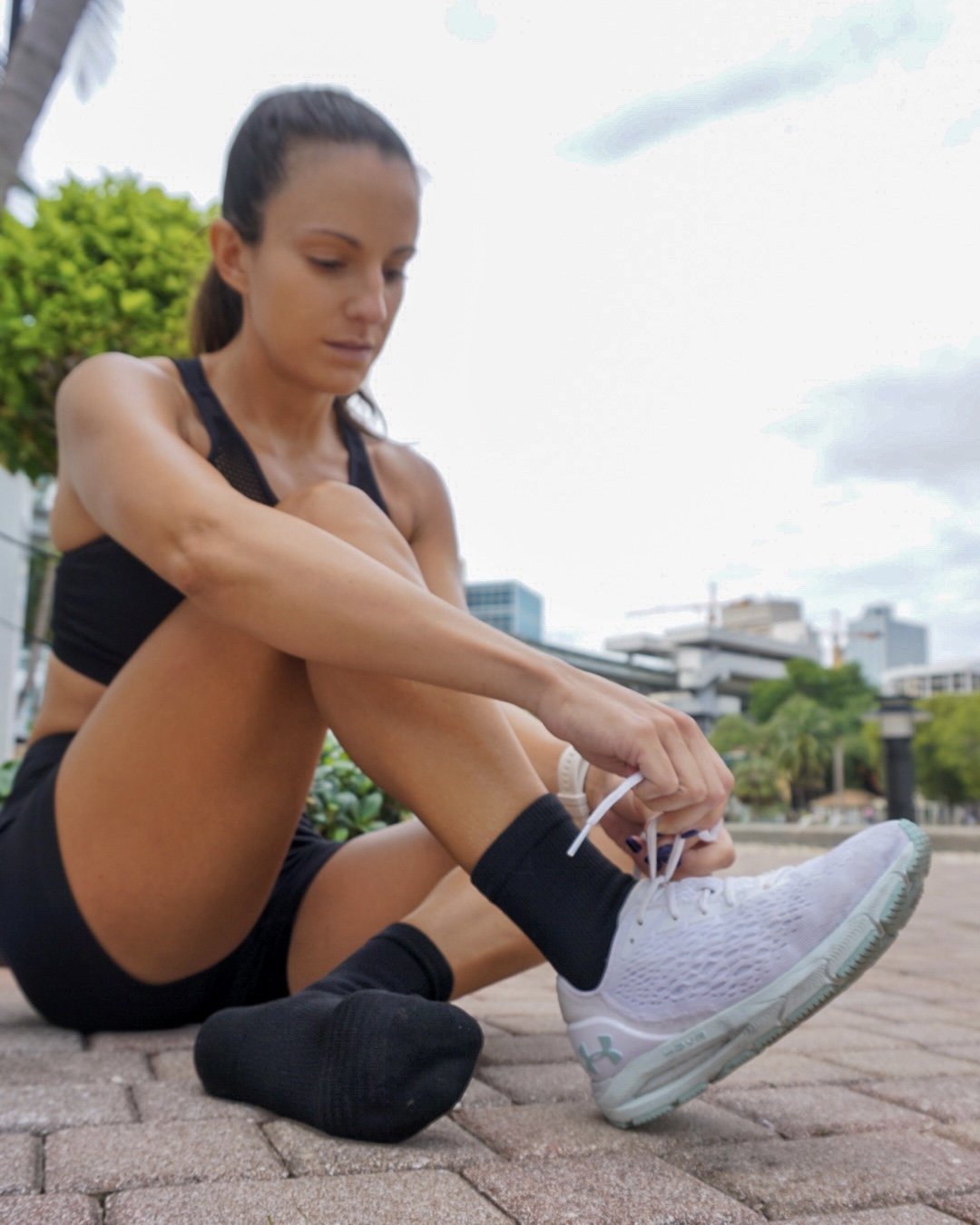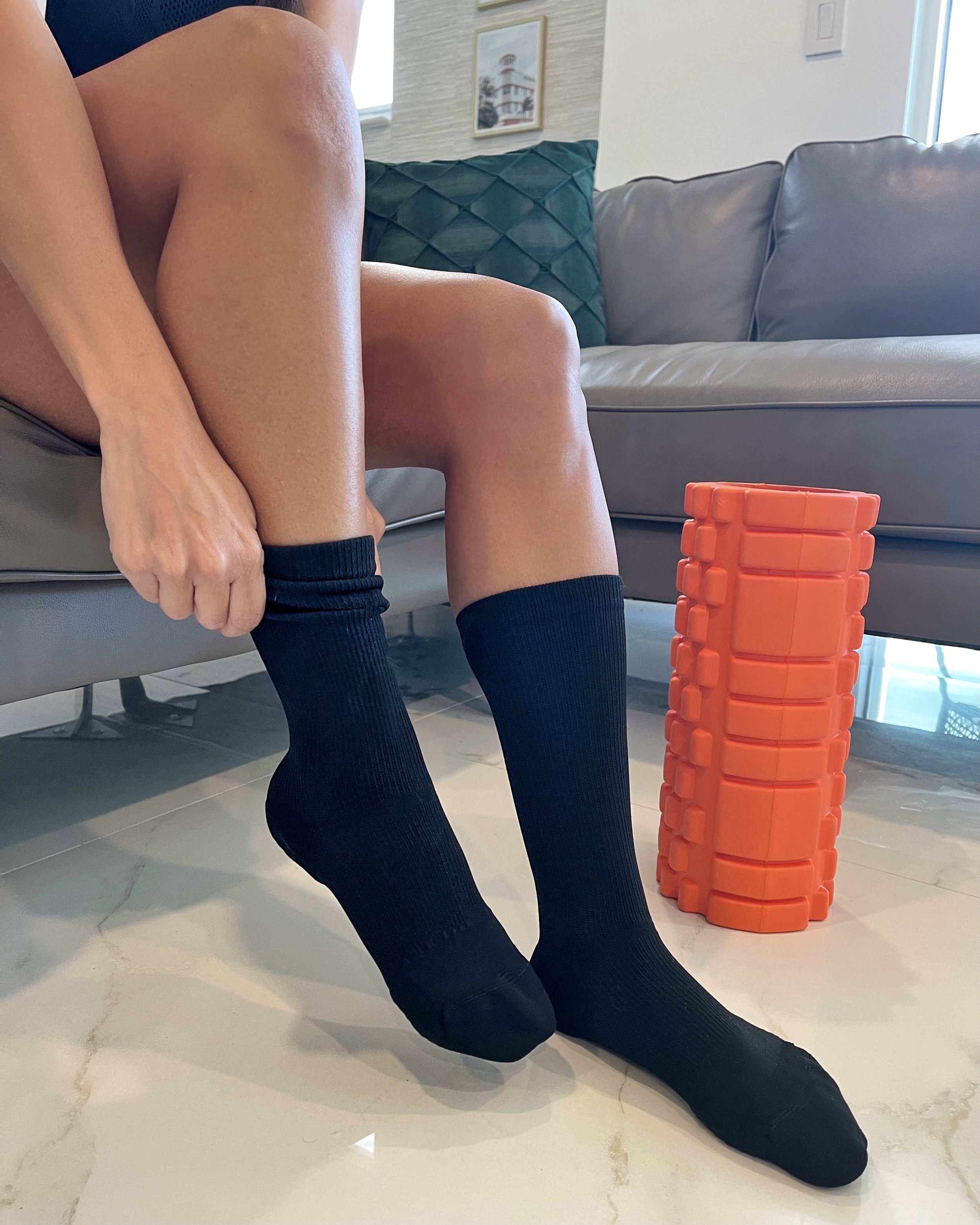IT Band Syndrome (ITBS) is one of the most common injuries in runners, especially in those new to the sport. The Iliotibial Band is a thick tendon that runs from the outside of the outer hip bone all the way down to the outer knee. Repetitive motions, such as in running, can overuse this area and cause inflammation. Read on to learn what steps to take whether you are just experiencing new symptoms or have been dealing with them for a long time.
Read moreRun Fast and Recover Faster with Apolla Performance Socks
From racing shoes to headlamps and everything in between, runners can be quite picky about their gear. As time goes on and technology advances, runners want the best of the best to be able to perform well, stay away from injury, and recover as fast as possible. Believe it or not, socks play a significant role in foot health for athletes. They are not just made to add a layer of cushion in between the skin and shoe seams. They can provide the feet, and pretty much every joint up the body, with support and injury prevention no matter what your lifestyle dictates.
Comfort is Always Number One
The first thing we aim for when picking out any piece of an outfit, shoes, or socks, is comfort. Runners, in particular, don’t care as much about looks, as long as they can feel comfortable on their long runs and avoid issues like achy joints, blisters, and heaviness. This all can be solved with a good pair of socks. In comes Apolla Performance. Initially created for dancers, who we can all agree get the most beating to their feet, these styles are equally perfect for any lifestyle. Just recently a research study concluded their effectiveness in reducing force and received the American Podiatric Medical Association Seal of Acceptance.
Apolla Performance socks are all made in the USA with REPREVE, which is certified sustainable yarn. Runners are sure to be happy with the Amp (no-show), the Performance (crew), and the Infinite (mid-calf), since they all provide the perfect thickness to protect from impact, blisters, and moisture, without feeling suffocated in running shoes. Each has energy absorption padding in the heel and ball of the foot which helps cushion during both push-off and landing—the parts of the running cycle that damage the feet the most. If you suffer from plantar fasciitis, you will be grateful for this feature!
Instability is the Enemy
As a physical therapist, I am an advocate for creating the most stable surface during the running cycle. This means being extra picky about the shoes and socks you wear. Weak, overused, or tired ankle and foot muscles can lead to ankle rolls and strains in the tiny muscles of the foot from the constant work when your foot and ankle are not supported well. Apolla Performance socks are made with targeted high compression where you need it the most—around the ankle joint and the arch of the foot. The arch actually has three zones of compression to lift and stabilize, which makes a significant difference if you suffer from plantar fascia issues. In these cases you want to prevent your arch from getting too stretched out, which will end up tugging on your heel bone. It’s a tough condition to treat, so you want to do anything you can to avoid too much pressure to this area!
Work Hard, Recover Harder
The mid-calf Infinite Sock from Apolla Performance is the best choice for both recovery runs and your rest days. Providing your feet and lower legs with compressive support is ideal to help with circulation—the key to recovering faster. This is best done with graduated compression up the calf, which is exactly what this pair provides. Using compression socks during and after runs, especially speed workouts and long runs, is ideal for those suffering from achy calves, shin splints, Achilles tendinitis, and any other foot and ankle conditions. You want good blood flow and comfortable cushioning if you want to be fully ready for your next workout. If you are looking for happy and healthy feet, Apolla Performance has you covered!
Running with Arthritis? Here's All You Need to Know to Stay Healthy
One of the most common complaints of pain for most adults is caused by arthritis. This condition can become extremely debilitating and limit the ability to enjoy even the simplest activities. It has been a common thought that running is harmful to joints and causes arthritis. Recent research has shown the opposite results. Running can actually help control the symptoms of arthritis. Early signs are often ignored as they are usually short-lived and infrequent and can mimic other conditions such as overuse symptoms and muscle soreness. If you are a runner or partake in other activities, it is beneficial to understand the causes, symptoms, and management options available in order to avoid requiring invasive treatment.
What is Arthritis?
According to the Arthritis Foundation, the condition is just a term used to described joint disease and includes over 100 different types. It is most common in adults, but many of these types of arthritis can be found in children, as well. The cartilage located in between bones, which acts as a “cushion”, is lost creating constant pressure during activities. The earliest symptoms include joint stiffness, pain, and swelling. As mentioned, these can last a short time and occur infrequently. Stiffness is usually felt the most after prolonged positioning such as sitting or when getting out of bed in the morning. When in motion, the stiffness is usually relieved. In more advanced stages of arthritis, significantly prolonged activities can make the pain worse. Over time, arthritis can cause visible joint changes such as enlarged knuckles. Other joint deformities are only visible with X-rays.
Unfortunately, arthritis cannot be cured, but there are several management strategies available that can allow you to live comfortably without sacrificing your desired activities. The most important treatment approach, especially in the early stages, is balancing aggravating activities with rest. The key is to control the buildup of inflammation in order to avoid extreme pain to the point where you must take too much time off. For runners, this means if you are beginning to feel symptoms during or after a 10-mile run or longer, than you should be cutting back to shorter runs and adding in other cross-training activities, including strength training.
Strength Training is a Must
The constant grinding of bones with arthritis is what naturally causes pain and swelling. Getting the surrounding muscles stronger can help relieve this pressure. Stronger muscles also mean you can tolerate activities for a longer period of time, such as getting back to those 10-mile runs and racing marathons. Yes, this is possible, but runners must understand that strength training needs to become part of their regular training regimen. It is also the best way for non-runners to help control their symptoms and possibly avoid worsening arthritis and requiring surgery.
For hip and knee arthritis, which is one of the most common areas affected, especially in runners, it is important to alternate between bodyweight and resistance exercises. Both offer strength gains but give the joints a break from too much impact. Exercises should incorporate the larger muscle groups such as the quads, hamstrings, glutes, and calves, as well as smaller muscles that play a role in hip and knee stabilization. These smaller groups are the hip abductors and adductors, internal and external rotators, and the core muscles. Besides squats, lunges, heel raises, and step-ups, which all target the larger muscle groups, floor exercises for the lower body are an easy way to get in strength training at any time. Bridges, clamshells, and hip extensions are all great exercises that can be done with or without a resistance band. Core exercises such as planks and leg raises are also good additions.
Management for Runners
Besides alternating runs with lower impact cross training, there are several other strategies to help relieve symptoms. Using hot packs before activities can help ease pain and stiffness and the use of ice afterward can help control inflammatory buildup from your workout. Over-the-counter anti-inflammatory medications can also help manage symptoms. Below are other methods specifically for runners with arthritis.
Use a run-walk method during most runs
Eat a low-inflammatory diet. Examples of foods that help lower inflammation in the body include fruits, vegetables, whole grains, nuts, beans, and fish. Foods that can increase inflammation include fried foods, high gluten foods, processed and high-fat meats, dairy products, and foods with trans fats.
Run on softer surfaces. Consistent road running causes repetitive pounding on joints. Try alternating running on trails, grass, and the treadmill.
Warm-up properly. Getting right into running on stiff joints can exacerbate symptoms. Incorporate dynamic stretches such as leg swings, lunges, hamstring and quad pulls, and ankle rolls before every run.
Exercise consistently. Avoid taking long breaks in between workouts. Even if you do not have time for your training runs due to a busy work and family schedule, you can increase the amount of walking during the day by parking further from your destination, stretching while cooking dinner, or waking up 15 minutes earlier to add in a few exercises before starting your day.
Sources
Paul T. Williams, Effects of Running and Walking on Osteoarthritis and Hip Replacement Risk, Journal, Sep 2019
Ponzio DY, Syed UAM, Purcell K, Cooper AM, Maltenfort M, Shaner J, Chen AF, Low Prevalence of Hip and Knee Arthritis in Active Marathon Runners, Journal , Sep 2019
Arthritis Foundation, What is Arthritis?, Website, Sep 2019







